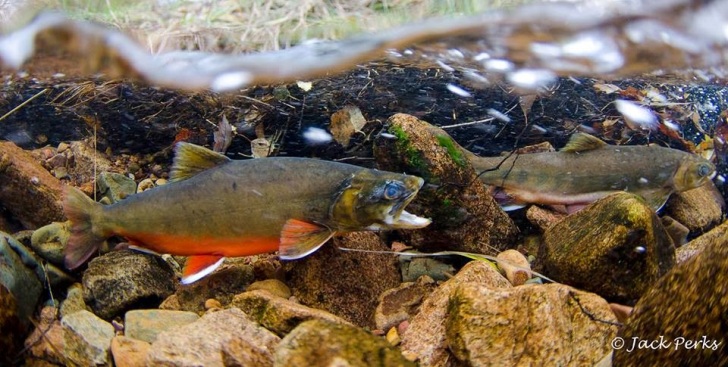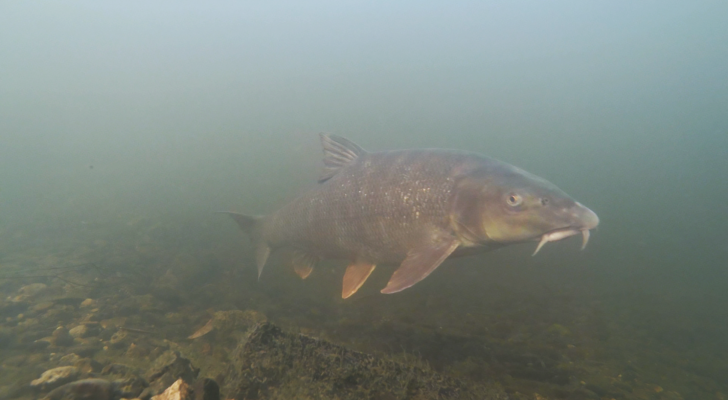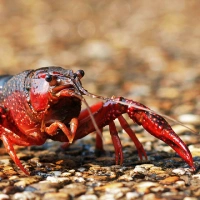Beneath the Waterline: an interview with underwater filmmaker Jack Perks

Arctic char. Image: Jack Perks
Underwater filmmaking has a rich – but largely oceanic – history, from Austrian biologist Hans Hass’s pioneering work in the 1940s and Folco Quilici’s 1954 first full-length full-colour film Sesto Continente through to stunning modern footage such as in the BBC’s Blue Planet series and in Werner Herzog’s Encounters at the End of the World.
Jack Perks, an English natural history photographer and filmmaker, is attempting to bring freshwater environments into focus through his Beneath the Waterline project, which aims to document all of the UK’s freshwater fish on film. Keen to find out more, we spoke to Jack about his work and the challenges of filming freshwater life.
Freshwater Blog: Hello Jack, tell us a little bit about your work – how did you begin as a natural history photographer and filmmaker? What’s your approach to documenting the natural world?
Jack Perks: I started my professional career around 4 years ago when I left university with a degree in Marine and Natural History Photography and although I enjoy all aspects of British wildlife, it’s our fish that really caught my attention. With no specific NGOs for freshwater fish in the UK and very little photographic or video footage of them I decided it was about time to change that!
Tell us about the Beneath the Waterline project – what is it and where are you up to with the project work?
The project started in March 2014 and is funded mostly by donations from the public as well as a generous contribution from The Fisheries Society of the British Isles which enabled me to travel all over the UK to film. I had two goals for the project. One was to film as many British freshwater fish as possible, with an emphasis on native species, but also including non-natives and some sea fish that venture into river mouths.
The second goal was to create a film and short 1 – 3 min videos which are put on the project website to provide an online fish I.D guide. I will present the main film, which will deal with conservation issues like getting kids into nature, trying to get nature reserves to watch and appreciate the underwater world, and will feature species such as elvers (young eels) on the River Severn in Gloucester and the rare powan in Scotland. The film is nearing its end with one more presenting piece to be shot and a few more species to tick off.

Powan. Image: Jack Perks
It’s interesting that you raise the point that there’s no NGOs for UK freshwater fish (although there are a lot of broader freshwater ones) and little film footage: why do you think this is? Do you think we ignore freshwater life below the water’s surface? Is this something you’re trying to address with the Below the Waterline project?
One of the key points of the film is to raise awareness of our fish in general, particularly species most people haven’t heard of like spined loach, lamprey and Arctic char. I think the main reason for this lack of public awareness is “out of sight out of mind”, with so many species largely hidden below the water’s surface, most people don’t notice if they decline. I think that most people don’t even know whats lurking in the rivers, canals and lakes around them, so the film uses a mixture of close-up filming in tanks and shots of fish in their natural habitat. I’m hoping to show off our incredible diversity of freshwater fish species.
What technical challenges did the Below the Waterline project throw up? How did you go about finding the species to film (surely some must have been more difficult than others!), and what’s your working method for capturing them on film?
Timings were crucial and did cause me to miss a few species (like the river lamprey and shad) that I would very much like to have filmed. Most cyprinids breed in spring so it was a mad dash to try to capture as much breeding behaviour as possible, which meant that I did miss a few while trying to film others. Also I had to juggle the filming around commissions and filming for other groups while doing this project.
Being an angler helped me locate a lot of the fish, as did social media (here’s the project twitter account), with an army of people suggestion locations to go and film in places including London, Sheffield, Gloucester, Devon, Stirling, Cumbria and all over the East Midlands (my home region). I use a few filming methods including pole cams, underwater camera traps and snorkeling in rivers.

Barbel. Image: Jack Perks
One of the hardest fish to film was barbel. This was surprising, as I have quite a lot in my local area but the river water where they live was either too deep or murky to film. I had no success until a local angler told me about a suitable spot only 15 minute from my house and got them first time!
What has been your favourite fish to film, and why?
The barbel was certainly relieving to finally get but if I had to choose one, it would be the sea lamprey. I had people looking out for them on three different rivers and at the drop of a hat I’d travel to where one was spotted. I got a call from a river keeper on the Test (in Southern England) to tell about lampreys in the river, and so I got the first train to Southampton to film this primordial looking creature. It turned out that the conditions were ideal and plenty of sea lamprey were around spawning so I got lots of footage. They are incredible to watch as they move huge rocks to form a redd and move over each other in courtship.
The Below the Waterline film is coming out soon – can you tell us about it and where we can see it?
The premiere will be in Nottingham with showings in Bristol, London and more locations further north, and will also be available to buy on DVD and online. The hope is that the film will make people think a little more about freshwater fishes in different ways – they’re not just food for birds or a target to be hooked but an important part of our natural history and deserve to be celebrated as much as any other creature in the UK.














